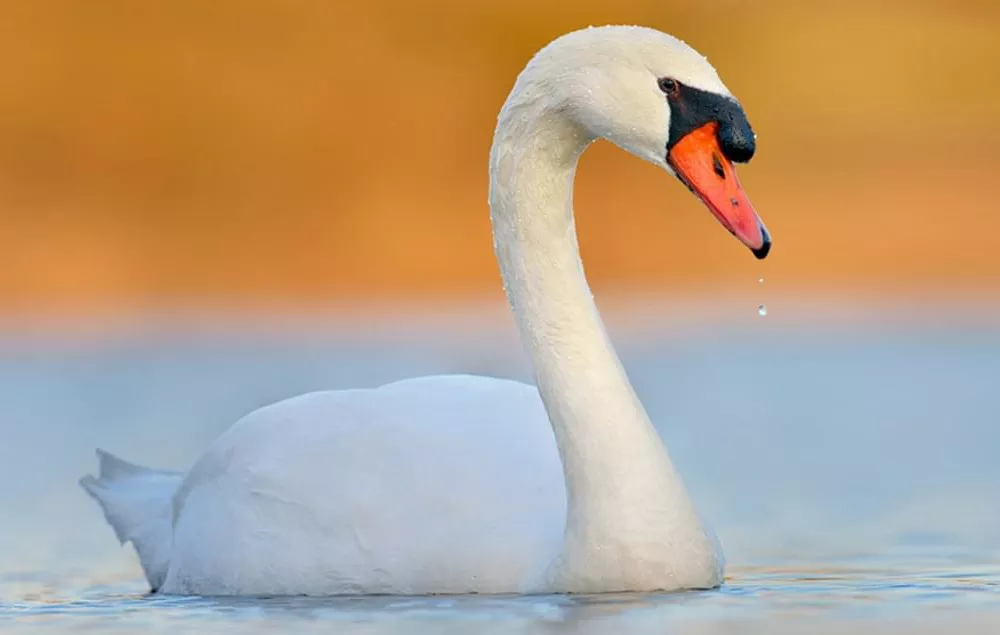The mute swan (Cygnus olor) is the national bird of Denmark, admired for its grace, beauty, and cultural significance. This large waterbird is easily recognizable by its pure white plumage, distinctive orange beak with a black knob at the base, and elegant curved neck. The mute swan is widely found throughout Denmark’s lakes, rivers, and coastal waters, symbolizing peace, purity, and natural heritage.
Denmark officially designated the Mute Swan as its national bird in 1984, following a public poll. However, the swan’s connection with Denmark goes back centuries, deeply rooted in mythology, literature, and art, particularly through the famous fairytale “The Ugly Duckling” by Hans Christian Andersen.
In this article, we will explore the Mute Swan’s taxonomy, physical traits, habitat, behavior, conservation status, cultural significance in Denmark, and the reasons it was chosen as the national bird.
Biological Overview of the Mute Swan
Scientific Classification
- Common name: Mute Swan
- Scientific (Latin) name: Cygnus olor
- Danish name: Knopsvane (sometimes also Knös swan in older usage)
- Order: Anseriformes
- Family: Anatidae
- Subfamily / genus: Cygnus
Within the genus Cygnus, the Mute Swan is distinct for several morphological and behavioral traits. Unlike “whooper” or “trumpeter” swans, it is relatively quieter in vocalizing, hence the common name “mute.”
Physical Characteristics
The Mute Swan is one of the largest flying birds in Europe. It combines elegance with power. Below are key traits:
- Size & wingspan: Adult swans can reach lengths up to about 160 cm (1.6 m) and wingspans up to 238 cm (2.38 m)
- Weight: Individuals weigh typically between 9 and 14 kg (sometimes heavier), making them among the heaviest flying birds.
- Plumage: Mature birds are entirely white. Young birds (cygnets) display grayish down which gradually turns white as they mature.
- Bill / knob: The bill is primarily orange with a black base and a prominent black knob above the bill in males (and smaller in females).
- Legs & feet: Dark grey to black legs, webbed feet suited for swimming.
- Posture & movement: Long S-shaped neck; graceful gliding on water and powerful wingbeats in flight.
One distinctive aspect is that the Mute Swan produces a unique sound from the beating of its wings during flight — a throbbing or whirring sound — that is more recognizable than its vocal calls.
Habitat and Distribution
Mute Swans are native to Europe and parts of Asia, but they have also been introduced to North America and Australia. In Denmark, they are found throughout the country, especially in:
- Shallow lakes and ponds
- Coastal lagoons
- Fjords and estuaries
- Urban parks and canals
These birds thrive in environments with abundant aquatic vegetation, which they feed on by dipping their long necks underwater.
Diet and Feeding Behavior
Mute Swans are primarily herbivorous, feeding on aquatic plants, algae, and occasionally small insects or mollusks. They graze underwater using their long necks to reach vegetation growing on lakebeds.
Their feeding helps maintain ecological balance in Danish wetlands by controlling excessive plant growth, thus promoting biodiversity.
Mute Swan Behavior and Life Cycle
Mute Swans are famous for their monogamous relationships. Once a pair bonds, they often stay together for life. Their elegant courtship rituals—marked by synchronized swimming, mutual head-bobbing, and wing displays—symbolize love and loyalty, traits that make them beloved icons of romance in Denmark.
Nesting and Reproduction
- Breeding Season: April to June
- Nest Type: Large mound built from reeds and grasses, usually near water
- Eggs: Typically 4–7 pale green or blue eggs
- Incubation Period: Around 35–38 days
Both parents play active roles in raising their cygnets. The female (pen) incubates the eggs while the male (cob) guards the nest fiercely. After hatching, the cygnets are able to swim within hours and remain with their parents until autumn.
Vocalization and Sounds
Despite the name “mute,” the Mute Swan is not entirely silent:
They communicate with grunts, snorts, hoarse whistles, and hisses, particularly during nest defense.
Migration Patterns
Most Danish Mute Swans are non-migratory, staying in Denmark year-round due to its mild coastal climate. However, some northern populations may move south during harsh winters.
Large flocks can often be seen in shallow bays and fjords during winter, creating one of Denmark’s most picturesque natural sights.
Conservation and Protection of the Mute Swan
Legal Protection
The Mute Swan is legally protected under Danish and European wildlife laws. Hunting or disturbing swans and their nests is strictly prohibited.
This protection has helped the species recover from historical declines. In the early 20th century, hunting and pollution caused population drops, but strong conservation policies have since restored healthy numbers.
Population Status
Today, Denmark hosts an estimated 10,000–15,000 breeding pairs of Mute Swans, making it one of the most abundant waterbirds in the country.
The swan’s success story is a testament to Denmark’s commitment to environmental conservation, serving as a model for protecting other native bird species.
Environmental Challenges
Despite their stable population, Mute Swans face several threats:
- Pollution: Contaminated waterways can reduce aquatic vegetation and affect food sources.
- Habitat loss: Urban development and agricultural expansion sometimes encroach on nesting sites.
- Climate change: Rising sea levels and shifting weather patterns may alter their wetland habitats.
Denmark continues to implement policies aimed at preserving wetlands and improving water quality to safeguard the swan’s habitat.
The Symbolism of the Mute Swan in Denmark
A National Icon of Beauty and Grace
The Mute Swan represents elegance and tranquility. Its pure white plumage and gentle gliding across Danish lakes make it a symbol of peace and natural beauty. For centuries, the swan has been admired by artists and poets, often appearing in Danish folklore and art as a symbol of purity, transformation, and love.
In Danish culture, the Mute Swan’s beauty reflects the harmony between humans and nature—a central theme in Denmark’s environmental philosophy. The country’s lakes, fjords, and coastlines provide ideal habitats for these graceful birds, reinforcing their natural connection to the Danish landscape.
Connection to Hans Christian Andersen
Perhaps the most famous link between Denmark and the swan comes from Hans Christian Andersen’s 1843 fairytale “The Ugly Duckling.” In this timeless story, a young bird is mocked for being different, only to grow into a magnificent swan—an allegory for personal transformation and self-acceptance.
This story not only celebrates the beauty of the swan but also mirrors Denmark’s cultural values of compassion, growth, and individuality. Andersen’s tale helped elevate the swan into a cultural symbol recognized far beyond Denmark’s borders.
Historical Symbol of Royalty
Swans have long been associated with royalty and nobility in Europe. In medieval Denmark, swans were often depicted in royal coats of arms and family crests. The bird’s regal posture and elegance made it a natural emblem for kings and queens.
Even today, the swan remains a royal symbol in Denmark. It appears in Danish postage stamps, coins, and national artwork, symbolizing the country’s continuity and refined cultural heritage.
Why the Mute Swan Was Chosen as Denmark’s National Bird
When Denmark held a public poll in 1984 to choose its national bird, the Mute Swan won overwhelmingly. Its popularity stemmed from several reasons:
- Cultural symbolism: Deep ties to Hans Christian Andersen’s stories.
- Natural beauty: Ubiquitous presence across Danish landscapes.
- Peaceful nature: Representation of Denmark’s values of harmony and balance.
- Recognition: A bird that both locals and visitors easily identify with Denmark.
The selection of the Mute Swan reflects how Danes perceive themselves—graceful, resilient, and connected to nature.
Interesting Facts About the Mute Swan
- A Mute Swan’s heart beats about 120 times per minute while at rest.
- They can fly up to 80 km/h (50 mph) despite their large size.
- Swans are known to form lifelong bonds, but if a partner dies, the survivor may find a new mate.
- The word “mute” refers to the bird’s relative quietness, compared to vocal swan species.
- Young cygnets are grey or brown and turn white within their first year.
- The Mute Swan’s flight produces a unique humming sound, created by air passing over its wings.
Conclusion
The mute swan is more than just Denmark’s national bird; it is a symbol of elegance, resilience, and cultural heritage. Through its biological grace, adaptable habitat use, and strong cultural ties, the mute swan connects the Danish people with their natural environment. Conservation efforts ensure that this magnificent bird continues to thrive, maintaining its rightful place as one of Denmark’s most cherished symbols.
Frequently Asked Questions (FAQ)
1. What is the national animal of Denmark?
The national animal of Denmark is the Mute Swan (Cygnus olor). Known for its elegance and grace, the mute swan symbolizes purity and peace. It became the national animal in 1984 and is often seen on Danish lakes and coastlines.
2. What is the national flower of Denmark?
The national flower of Denmark is the Marguerite Daisy (Leucanthemum vulgare). It was officially chosen in 1987 and is admired for its simple beauty and resilience, symbolizing purity, harmony, and the Danish love for nature. The flower is often seen blooming across the Danish countryside in summer.
3. What is the national tree of Denmark?
The national tree of Denmark is the European Beech (Fagus sylvatica). Beech forests cover large areas of the country and are an important part of Denmark’s landscape and ecosystem. The tree symbolizes endurance, strength, and natural beauty, reflecting Denmark’s deep connection to its forests.
4. What is the national fish of Denmark?
In 2025 Denmark elected its first national fish through a public vote: the European plaice (rødspætte). The plaice won by a large margin in a nationwide poll, becoming Denmark’s symbolic national fish.
5. What is the national dish of Denmark?
The national dish of Denmark is Stegt flæsk med persillesovs, which means “crispy pork with parsley sauce.” This traditional meal consists of fried pork belly served with boiled potatoes and a creamy parsley sauce. It reflects Danish comfort food culture and is loved for its hearty, home-cooked flavor.


 Facebook
Facebook  Instagram
Instagram  Youtube
Youtube 